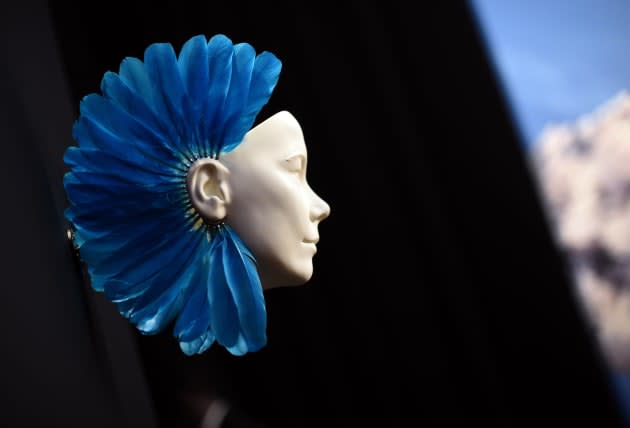Virtual reality stole my dance with Bjork

Maximum Bjorkness! That's what I came in expecting at MoMA PS1, the Museum of Modern Art's Queens-based offshoot, where the famous musician/distressing fashionista's new virtual reality exhibit is on display. "Stonemilker," a lilting, melancholy track from her new album Vulnicura, is the basis for Bjork's foray into VR. Considering the freaky name -- Stone milk? Gross. -- the harrowing emotional subject matter of her new record and the tech, you can understand why I arrived ready to get weird.
This is the same person that turned the song "All is Full of Love" into a Chris Cunningham-directed video that forces you to confront the sexual nadir of the Uncanny Valley. This is the artist who helped Lars von Trier make a movie about a singing blind woman that simultaneously fills you with awe at the world's beauty and makes you want to die because of its cruelty. Now she's made an album boldly chronicling the dissolution of her marriage to artist Matthew Barney and filtered that through virtual reality filmmaking? Sign me up.
Much to my disappointment, however, the "Stonemilker" experience is neither as strange nor as harrowing as I'd hoped it would be. It was beautiful and intriguing, but it was also irreparably hindered by the inherent limitations of VR gear.

Inside the Stonemilker exhibit at MoMA PS1.
Rather than present an ethereal fantasy world of robot ladies and techno-organic sprites, the exhibit itself feels almost nostalgically familiar when you enter. A small dome set up just inside PS1's entry, it's kind of like a sturdier version of an elementary school planetarium, only full of hipsters instead of children. The room is dark, save for a dusky image of Iceland's volcanic coastline projected on the ceiling, and the soft sound of waves crashing fills up the interior without ever becoming too loud. It's inviting and warm, but still strange and scary: a perfect atmosphere for the music on Vulnicura. In the center are a series of stools you're required to sit on so you can spin around in 360 degrees after strapping on a pair of sharp headphones and Freefly VR headset to enter "Stonemilker."
The compulsion to dance with her as the song goes on is almost overwhelming. But no, you have to remain seated on the stool.
Andrew Thomas Huang's seven-minute virtual reality video for "Stonemilker" is actually quite lovely. Bjork herself stands before you on the same coastline projected in the dome outside your helmet of technology. Wearing a billowing green dress, she sings about the moment when one person in a relationship sees things clearly and the other doesn't; when their ability to feel changes and blooms while their partner's calcifies. She spins around you, and you in turn spin around on the stool to follow her, and before long she's split into two and three people filling your view. Rather than a ghostly effect, it all feels like living in the moment of a memory. Was she standing next to me while I looked at the lighthouse in the distance or behind me? Could I see her when she described getting me to talk like "milking a stone?" Even the gauzy pixelation of the headset's screens -- often referred to as the "screen door effect" -- makes the video feel like something slightly unreal.
As the minutes clock by while the music dips and swells, though, the confines of that damn stool start to chaff the brain. I can only spin around and try to follow the singer as she dots the landscape, staring at the sky or blackened ground every now and again to try and push at the edges of just how far the technology will let me go. Forget walking over to where she's standing or to the waves hitting the rocks. Lean too far from center and the image starts to warp, Bjork's face getting comically big like a member of the Peanuts gang. The compulsion to dance with her as the song goes on is almost overwhelming. But no, you have to remain seated on the stool.

Headdress art (is that what that is?) from Bjork's MoMA retrospective.
Of course you have to sit on the stool! Even if the VR tech did offer free roaming, which it doesn't, you'd still be locked to the stool. Not only would giving you free reign over the beach damage the choreography already in place, but also the exhibit space itself would be a nightmare! Imagine bespectacled, bearded dudes and chicks in pastel-hued Lisa Loeb glasses bumping into each other left and right, damaging the VR helmets and creating a lawsuit quagmire for the museum in the process. The stool allows for a coherent artistic vision and a safe audience space even as it leaves you feeling trapped.
The argument could be made that isolation is the point. "Stonemilker" is, after all, a song about an ever-widening chasm between two people. The roles in VR work are still undefined, but whether you're a viewer, listener or participant here, you're still always divorced from the performer. The multitude of Bjorks pirouetting around your fixed position brings that gulf into stark relief.
Intentional or not, "Stonemilker" doesn't quite work. Any kind of emotional resonance created by your near-separation from the work is drowned out by the physical alienation of the technology itself. Regardless, for fans of Bjork, it's still worth a visit. "Stonemilker" is still a lovely song and the exhibit's still a cool space even if the Bjorkness on display isn't at extra strength.
Correction: An earlier version of this article misstated the virtual reality headset used. It was "Freefly VR," not "Oculus Rift."
[Images: Andrew Thomas Huang (lede image); Matt Hawkins/Attract Mode ("Stonemilker" exhibit); Timothy A. Clary/AFP/Getty Images (Bjork MoMA headdress)]

